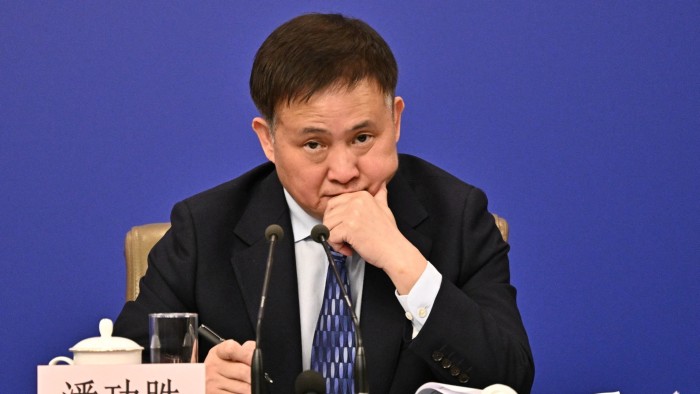Stay informed with free updates
Simply sign up to the Chinese economy myFT Digest — delivered directly to your inbox.
China has said it will cut its benchmark interest rate and reduce the amount of money banks need to hold as reserves, offering support for the economy in the face of a trade war with the US.
China will lower banks’ reserve requirement ratio by 0.5 percentage points and cut several key interest rates to release Rmb1tn ($138bn) of long-term liquidity into the banking system, said Pan Gongsheng, governor of the People’s Bank of China.
Pan, speaking at a news conference on Wednesday alongside officials from two other financial regulatory agencies, said the central bank would cut the benchmark seven-day repo rate by 0.1 percentage points to 1.4 per cent and reduce deposit and other interest rates for refinancing loans.
Beijing rolled out the measures amid a bruising trade war with the US that is starting to hit the country’s vast manufacturing sector, with many export orders cancelled and factories starting to furlough workers and reduce production.
Beijing and Washington said on Wednesday that they would hold their first trade talks since US President Donald Trump launched a trade war against China, as both sides look for a way to reduce punishing tariffs.
The trade war comes as China is already battling weak domestic demand, forcing Beijing into successive waves of monetary policy easing since last year.
Pan said the latest measures were due to “uncertainties of global economy, economic fragmentation and trade tensions, which disrupted global industrial supply chains”.
The cut to the banks’ reserve requirement ratio (RRR) would lower the weighted average across the sector from 6.6 per cent to 6.2 per cent, Pan said.
Analysts say the co-ordinated policy announcements reflect Beijing’s desire to support its economy and boost market confidence ahead of US-China negotiations over trade.
“The timing of the package is closely linked to the US-China trade talks,” said Lynn Song, chief economist for Greater China at ING. “Rolling out easing measures now helps avoid the appearance of a knee-jerk response to tariffs.”
The PBoC will also cut the RRR for financial leasing and vehicle finance companies from 5 per cent to zero, a move that would release capital and improve their lending capacity.
The cost of securing long-term loans from a government-led programme for housing purchases would be cut by 0.25 percentage points to 2.6 per cent, Pan said, to “support the rigid housing needs of residents and help the property market stabilise”.
Recommended
Li Yunze, director of the National Financial Regulatory Administration, the financial sector watchdog, said China would roll out new measures to support exporters “with the goal of stabilising their operations and helping them expand their markets”.
He added that China would also unveil new financing mechanisms to support the ailing real estate sector and expand a pilot programme to inject more funds from insurance companies to flow into the stock market.
“We are fully leveraging the advantages of insurance funds as patient, long-term capital and will allow it to enter and stabilise the market in greater strength,” Li said.
Robin Xing, chief China economist at Morgan Stanley, said the overall policy stance remained “reactive and supply-centric”, and as such could only partially offset tariffs shocks. But he said the package beat “market expectations, and indicated room for further easing as needed”.
The “RRR cut is one of the vital moves to mitigate the
economic impact [caused by tariffs]”, Jianwei Xu, senior economist for Greater China at Natixis, said in a panel on Wednesday. “But stimulus measures need to be massive this year to achieve China’s 5 per cent GDP target.”
Hong Kong’s Hang Seng index advanced 2.2 per cent at the open, but the gains were cut later in the day. The mainland China CSI 300 index closed up 0.61 per cent. The offshore renminbi, which trades freely, was flat on the day at Rmb7.22 per dollar.
Additional reporting by Wenjie Ding in Beijing



